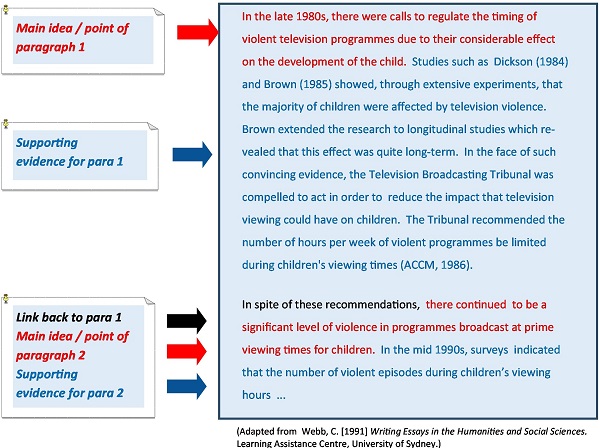Creating powerful paragraphs

Paragraphs are the ‘building blocks’ of academic writing. Writing paragraphs well makes your writing clearer and will improve your grades.
If you are writing short answers, you might write just one paragraph. In an essay, report, or other assessment, you will write many paragraphs. No matter what you are writing, there are several key points to remember when you write a paragraph.
Focus each paragraph on one main idea
Paragraphs are not like bullet-point lists. A paragraph is like a ‘mini story’ that focuses on one main idea and provides evidence and examples to support that idea.
Make that idea obvious to the reader in the first one or two sentences
Start with a broader idea, followed by more specific detail. If you are writing an essay, your reader should be able to read the first few sentences of every paragraph and come away with a clear idea of your overall answer to the essay question.
In the rest of the paragraph, include detail about the idea
Explain, provide evidence for, or discuss the idea in the rest of the paragraph. What detail to include depends entirely on the assessment question you have been given, so read the question carefully to determine what kind of supporting detail you need. For example, you might include examples, explanation, expert opinion, theories, facts or statistics.
Reference information you are using to support your idea
If any of the supporting information has come from sources you have read, or heard in lectures, you must include an in-text citation and a reference list entry.
Connect paragraphs to aid flow
Any piece of writing with a series of paragraphs, will need to have the paragraphs ordered so the main ideas form a clear logical sequence. Show the reader how the idea in each paragraph connects to the ideas which are before or after it. Include some words at the start of the paragraph that show the connection to the paragraph before. Or do this at the end of a paragraph to 'point forward' to the next one.
Check out Connecting Ideas to see how you can show the relationship between your ideas and guide the reader through your work.
Honestly, there is no one right answer.
Most paragraphs are at least 3 or 4 sentences. They need to be that long to (a) present an idea and (b) explain or discuss it. If your paragraph seems to be too short, you have probably not provided enough information to explain or back up the point. Think about what other detail or evidence is needed.
On the other hand, if your paragraph is too long (for example, more than 250-300 words or one page), it’s likely you are trying to explain more than one idea – or simply have too much information about a single idea. Identify where you stopped talking about one main idea and moved on to your next main idea. Separate the second main idea into a second paragraph. Edit out any unnecessary explanation or examples if there is too much information.
Look at how the writer of these paragraphs makes an overall point in each paragraph, uses detail to support the points, and links the two paragraphs.

How to take your paragraph writing to the next level
Following the key points in the sections above will help you write clearer paragraphs, but there are ways of making them even better.
- Join a workshop or make an appointment with a Learning Advisor to find out how to make your writing flow and how to develop an argument.
- Look for resources that will help you learn how to write sentences that fit smoothly together (called flow or coherence), and how to use a series of paragraphs to create an academic argument. For example,
Brick, J., Herke, M., and Wong, DE. (2020). Academic Culture: A Student's Guide to Studying at University. Bloomsbury. E-Book Chapter 18.
- Look at our information on how to structure an essay or report.
Get Individual Advice
Talk to Academic Success or attend one of our workshops for help with your study.


